While at the NetImpact Conference in Philadelphia, I had the opportunity to go on a sustainability tour of the Philadelphia Eagles’ Lincoln Financial Field. If you get a chance, go. What they are doing there is wide spread and very impressive.
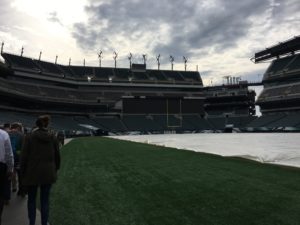 Fans might think they are coming to the Lincoln Financial Field for greasy food and violent entertainment but really they are coming to be part of the Eagles’
Fans might think they are coming to the Lincoln Financial Field for greasy food and violent entertainment but really they are coming to be part of the Eagles’ 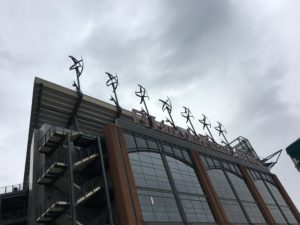
GoGreen team! What started in 2003 as an under-the-desk recycling program has grown into a comprehensive sustainability program that is embedded in the culture of the NFL franchise, permeating through its employees, players, grounds, buildings and operations. The Eagles story is one that shows that small, thoughtful, measured efforts can lead to big impacts.
Alternative Energy and Demand Reduction
The Linc’s highly visible alternative energy installation includes 11,008 photolvoltaic panels and 14 vertical turbines. The work horses of the solar installation are installed on canopies over parking lot K and up above the stands. The 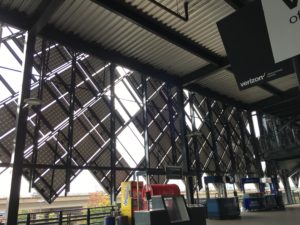 more visible, striking installation emblazoned across the south wall of the stadium faces Interstate 95 and delights the eye with a nighttime LED light show of an eagle flying while the turbines spin sculpturally overhead.
more visible, striking installation emblazoned across the south wall of the stadium faces Interstate 95 and delights the eye with a nighttime LED light show of an eagle flying while the turbines spin sculpturally overhead.
Through a 20-year rate and supply agreement with NRG, the Linc sources 100% of its energy through alternative sources and is able to manage its electricity costs by having a known, fixed electricity rate. The grid-tied solar installation generates 4MW of power which meets all of the Eagle’s game day power or 40% of the facility’s annual electrical demand. The other 60% is provided from solar and wind sources through NRG.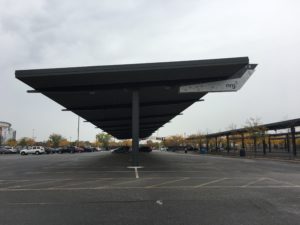
To complement its alternative energy efforts, the Linc is working hard to identify ways to save energy through a combination of efforts from 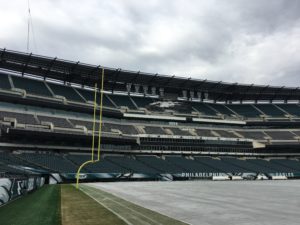 lighting control systems that include occupancy sensors, ‘left on’ lighting sweeps and timers, and a lighting replacement program that changes out fluorescent for LED as the original lamps blow-out.
lighting control systems that include occupancy sensors, ‘left on’ lighting sweeps and timers, and a lighting replacement program that changes out fluorescent for LED as the original lamps blow-out.
Just eyeballing the sports related parking lots surrounding the Linc, I estimate that the K Lot installation could be repeated 10 times. Imagine a collaboration between the city, the other sports team and a company like NRG that could generate 40MW of power while reducing heat island effect, keeping fans dry and having the capacity to capture rain water and divert it to green stormwater raingardens. 40 MW could possibly power 6,000 homes which is 8% of the South Philadelphia and 1% of the Philadelphia housing stock! What an opportunity!
Waste Stream Diversion
The Linc was 100% landfill free in 2015! That is a pretty extraordinary thing to say; especially when you consider that 70,000 people can fit into the stadium during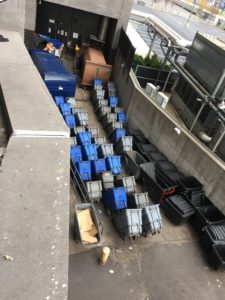 an event. This waste diversion is accomplished through an at-source separation program that combines: a closed loop cooking oil capture program; an aggressive, organized recycling program; a food waste reclamation and composting
an event. This waste diversion is accomplished through an at-source separation program that combines: a closed loop cooking oil capture program; an aggressive, organized recycling program; a food waste reclamation and composting 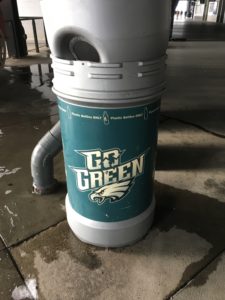 program; and the sending of all remaining waste to a waste-to-energy facility for burning.
program; and the sending of all remaining waste to a waste-to-energy facility for burning.
- Cooking Oil Capture: Collaboratively with Aramark, the facility’s food catering company, approximately 10,000 gallons of cooking oil is collected and sent to a local re-processor to be converted to biodiesel that is then used in the facility’s power equipment and some vehicles.
- At-Source Waste Sorting and Recycling: Over on the east side of the stadium is the field’s waste sorting center. Nothing leaves the field without being sorted into one of five different bins: glass, paper, aluminum, compostable food waste, and uncompostable-unrecyclable waste. The aluminum is kept separate and sold. Any revenue from recyclable sales is plowed back into the GoGreen program.
At the moment there is very little market for glass so it, paper, and any other recyclables go to the recycling center via the waste hauler.
- The Linc manages an on-site composting facility that processes 25 tons of food waste. This represents about 3% of the total compostable material generated by the fans and attendees. Part of the composting effort is focused on packaging. Working collaboratively with Aramark, the Linc seeks ways to reduce material destined to the landfill. So far, this has resulted in using compostable corn based utensils, cups and plates and the redesign of food wrappers
The remaining compostables currently go to a waste to energy facility with the non-compostable waste. This GoGreen effort results in a 99.8% waste diversion rate.
I was surprised and gladdened that the Linc composts. I was surprised that they took on the challenge because composting is a labor-intensive process that requires expertise to avoid smells and to get a nice even result. I was gladdened because municipalities on the east coast have been challenged to find a place that can compost their food waste. The one facility that was available for the mid-Atlantic was in Wilmington, DE but it recently closed due to mis-management of the process. If the Linc is able to process this much waste without anyone being aware of it then why not be able to scale up the process, locate it somewhere in an industrial area and start composting all of the waste streams from the surrounding sports venues. If that scaled up plan works well, then why not gradually start a city-wide program.
I was also heartened to see that a facility, by setting and communicating its goals, providing training and support to its employees, communicating the goals to fans and other attendees could reach a 99.8% waste diversion rate. They may not have achieved net zero waste but they have achieved net zero landfill waste.
Water
Being smart about water consumption has led the Linc to a reduction in recyclable plastic waste; less water bottles are being used at the facility by installing volume counting, water filtration, water bottle filling stations in the staff areas of the facility. Areas for public use installation are being identified.
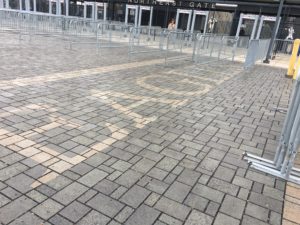 Water demand is managed by the installation of low-flow aerators at the sinks and low-gallonage toilets and urinals.
Water demand is managed by the installation of low-flow aerators at the sinks and low-gallonage toilets and urinals.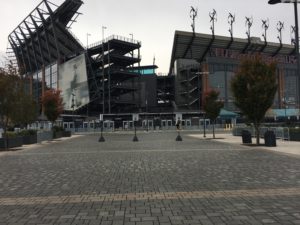 Water use for cleaning is being optimized by the use of Orbio Technologies electrolysis cleaning system that uses water, salt and electricity to create Sodium Hydroxide, a low impact, chemical free cleaning agent and degreaser. Much of the water used in the process is reclaimed and reused. This protects the waste water from being contaminated with chemicals and reduces cleaning dollars on chemicals.
Water use for cleaning is being optimized by the use of Orbio Technologies electrolysis cleaning system that uses water, salt and electricity to create Sodium Hydroxide, a low impact, chemical free cleaning agent and degreaser. Much of the water used in the process is reclaimed and reused. This protects the waste water from being contaminated with chemicals and reduces cleaning dollars on chemicals.
The Linc is also managing its stormwater by following green management practices in its parking lots. In support of The Philadelphia Water Department’s Green Cities, Clean Waters plan, the facility has installed two rain gardens; one on 11th and the other along Pattison Ave, to manage some of the stormwater from Lot K and has installed a porous paver ‘welcome mat’ near the stadium entrance. This brick paved area infiltrates stormwater from the parking lot and is emblazoned with the Eagles name and logo. This buffer not only makes the entrance something special, it reduces the load on the city’s combined sewer system.
Carbon Offset Through Tree Planting
To extend its sustainablity reach, the team offsets 100% of the carbon footprint it generates by travel to away games and other places by investing in tree planting. They calculate the carbon emissions for every bit of their travel from air miles to bus and other vehicle transportation to the hotel stay and then offset them with yearly tree planting in the 6.5 acre “Eagles Forest” in Neshaminy, Pa and several other parks around the country. The Eagles allow fans to offset their own carbon footprint by adopting trees through the program.
All of these efforts have helped the Eagles and their Linc achieve a 2013 LEED Silver certification from the US Green Building Council (O&M for Existing Buildings) and the 2014 Beyond Sport for the Environment Award in recognition of the GoGreen initiatives. These efforts have also led to the formation of the Green Sports Alliance that focuses on energy and carbon reduction at sporting venues.
Through leadership, education, collaboration, and team culture, the Eagles are making a huge sustainability impact and are providing a model for fans, other teams, and other venues to reduce their water, carbon and energy footprints while staying in the game. GoGreen!

{ 4 comments… read them below or add one }